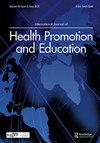“No tobacco” – still work to do
IF 0.7
Q3 EDUCATION, SCIENTIFIC DISCIPLINES
International Journal of Health Promotion and Education
Pub Date : 2022-05-04
DOI:10.1080/14635240.2022.2068257
引用次数: 0
Abstract
In 1988, the World Health Organisation (WHO) passed a resolution to raise awareness of the risks of using tobacco. It identified a specific day to do this, the 31 May (each year) and named it ‘World No Tobacco Day’. Each year, there has been a campaign to focus on particular risks, the practices of the tobacco industry and what can be done to protect people from tobacco use. On this day, it can be useful to remind ourselves about the dangers of tobacco, both for users and non-users and how we can support the fight to reduce and in time eliminate tobacco use. Although the WHO Framework Convention on Tobacco Control was agreed and published in 2005 (World Health Organisation 2005), with over 8 million people dying from preventable tobacco-related diseases each year (World Health Organisation 2022), the dangers of tobacco use remain and are familiar to health promoters and educators. Tobacco use can adversely affect the cardiovascular, respiratory, gastro-intestinal, neuro-sensory, skeletal, gynaecological and urological body systems. Tobacco use leads to poorer outcomes in maternity care for mother and infant. The latest data from the Institute of Health Metrics and Evaluation in the Global Burden of Diseases, Injuries and Risk Factors Study 2019 (Global Burden of Disease Viewpoint Collaborators 2020) identifies that globally, tobacco accounts (across all age ranges) for 21.4% of male deaths and 8.3% of female deaths. The report identifies that the annual rate of change (ARC) in exposure to this risk between 2010 and 2019 was reducing which was good news. However, with high but preventable mortality rates from tobacco use, it is clear that there is still much to be done. As with most health problems, disparity exists in tobacco use worldwide. Globally, there is higher mortality in lowand middle-income countries. Some regions of the world have higher use than others for example, Withers, Nguyen, and McCool (2020, p 287) identify that ‘the Asia Pacific region is home to 30% of the world’s smokers”. Nationally disparities exist too, and in the UK tobacco use reflects health inequalities in relation to economic status with the most disadvantaged communities more commonly using tobacco. The impact of tobacco use on the health of individuals and communities is understood. The impact on the economy is also considerable, as the costs of treating preventable disease and the days of productivity lost caused by tobacco use are around $1.4 trillion per year, which is about 1.8% of the world’s GDP (World Health Organisation 2022). This year, WHO is also focusing on another impact of tobacco use – its impact on the environment. WHO states that annual greenhouse gas contributions by the tobacco industry and the land used for tobacco growth each year – which could be utilised for food crops or prevent deforestation – contribute to large-scale damage to the climate (World Health Organisation 2022a) INTERNATIONAL JOURNAL OF HEALTH PROMOTION AND EDUCATION 2022, VOL. 60, NO. 3, 191–192 https://doi.org/10.1080/14635240.2022.2068257“无烟”——仍有工作要做
1988年,世界卫生组织(世界卫生组织)通过了一项决议,提高人们对使用烟草风险的认识。它确定了一个具体的日子,即每年的5月31日,并将其命名为“世界无烟日”。每年都会开展一场运动,重点关注特定风险、烟草行业的做法以及如何保护人们免受烟草使用的影响。在这一天,提醒自己烟草对使用者和非使用者的危险,以及我们如何支持减少和及时消除烟草使用的斗争,都是有益的。尽管世界卫生组织烟草控制框架公约于2005年商定并公布(世界卫生组织,2005年),每年有800多万人死于可预防的烟草相关疾病(世界卫生组织,2022年),但烟草使用的危险仍然存在,健康宣传者和教育工作者对此很熟悉。吸烟会对心血管、呼吸、胃肠、神经感觉、骨骼、妇科和泌尿系统产生不利影响。吸烟会导致母亲和婴儿的产妇护理效果较差。健康指标与评估研究所在《2019年全球疾病负担、伤害和风险因素研究》(《2020年全球疾病负荷观点合作者》)中的最新数据表明,在全球范围内,烟草(所有年龄段)占男性死亡的21.4%,女性死亡的8.3%。该报告指出,2010年至2019年间,这种风险的年变化率(ARC)正在下降,这是一个好消息。然而,由于吸烟造成的死亡率很高,但可以预防,显然还有很多工作要做。与大多数健康问题一样,世界各地的烟草使用也存在差异。在全球范围内,中低收入国家的死亡率较高。世界上一些地区的使用量比其他地区高,例如,Withers、Nguyen和McCool(2020,第287页)认为“亚太地区是世界上30%吸烟者的家园”。全国范围内也存在差异,在英国,烟草使用反映了与经济地位相关的健康不平等,最弱势的社区更经常使用烟草。人们了解烟草使用对个人和社区健康的影响。对经济的影响也相当大,因为治疗可预防疾病的成本和烟草使用造成的生产力损失约为每年1.4万亿美元,约占世界GDP的1.8%(世界卫生组织2022)。今年,世界卫生组织还重点关注烟草使用的另一个影响——它对环境的影响。世界卫生组织指出,烟草业和每年用于烟草种植的土地每年产生的温室气体——可用于粮食作物或防止森林砍伐——对气候造成了大规模破坏(世界卫生组织2022a)《2022年国际健康促进与教育杂志》,第60卷,第3期,191–192https://doi.org/10.1080/14635240.2022.2068257
本文章由计算机程序翻译,如有差异,请以英文原文为准。
求助全文
约1分钟内获得全文
求助全文
来源期刊

International Journal of Health Promotion and Education
EDUCATION, SCIENTIFIC DISCIPLINES-
CiteScore
2.30
自引率
10.00%
发文量
69
 求助内容:
求助内容: 应助结果提醒方式:
应助结果提醒方式:


